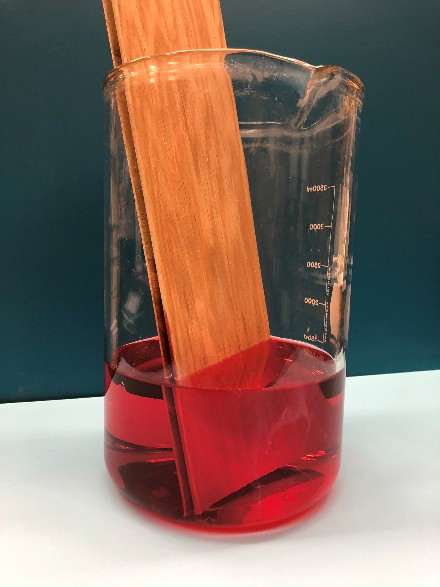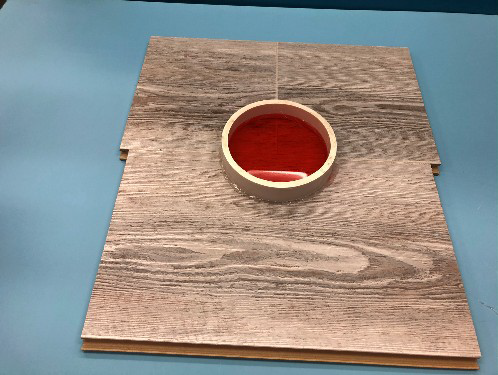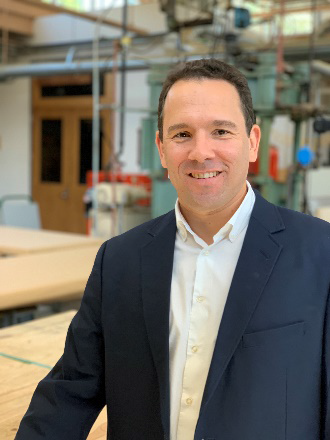Waterproof, Water-Resistant, & Moisture Resistant
The performance of floor coverings depends on many variables and not just one. I
teach this to anybody and everybody willing to learn more about the science of floors. This is
always an ongoing topic of conversation in the Hodges Wood Products Lab at NC State
University. We are constantly evaluating multiple properties of both domestic and
international products to help the industry understand the differences between product
categories and performance levels. A few years ago, the topic of “water-resistant” came into
the mix as one of the properties to be evaluated. Since then, we have worked on different
methods to assess this property and to properly understand what this means for in-service
applications.
Whole plank test
Walking around DOMOTEX USA, we will find whole products submerged in fish tanks. The
display presents how a product in its manufacturing configuration can be subjected to any
amounts of water without changing its dimensions or properties. This display is commonly
used for products where no components absorb water. In a laboratory setting, this test could
measure dimensional changes like thickness and squareness as well as change in weight.
The downside of this test is that no single plank is installed on its own and, in many cases,
planks are cut for layout dimensions. This test can also be time dependent. While some
products can withstand these conditions for a short period, others can handle much longer.
As an alternative to a submerge test, products can also be placed in a high humidity
conditioning chamber.
 Whole piece in high humidity chamber
Whole piece in high humidity chamber
Less-than-whole plank test
This type of test evaluates the performance of a section of the flooring product. For this
reason, the manufactured product receives at least one cut in order to expose the core of
the product and show the effect of water or moisture on the properties of the material. This
test can evaluate the same properties as a whole plank test except the manufacturing
tolerances on the cut edge. The cut on the product also removes any protection that may be
present on the joints of the product. Variants of the test include different numbers of cuts.
The simplest version involves one cut edge while more complicated tests include the cutting
and exposing of all sides and even parts of the top or bottom of the planks. When subjecting
the product to water the floor can be fully submerged or partially submerged. Partially
submerged methods allow us to determine capillary moisture movement, rate of absorption
inwards and differences between the edges and middle of a product.
 Partially submerged test
Partially submerged test
Assembled product test
An assembled product test derives from the understanding that a single piece of flooring is
not put in service by itself. These types of tests try to replicate in-service conditions to
understand the performance level of a product. Settings can be as large as 9’ x 6’, like
international methods under different environmental conditions, to multiple T-joints, like the
North American Laminate Floor Association’s (NALFA) topical moisture resistance test. This
last test looks at the ability of an assembled product to withstand the effects of surface
water while holding the water on the surface. While this methodology was developed for
floating floors, modifications can be made for other installation methods. Understanding how
a flooring system performs versus a single flooring element is of great importance. Products
need to perform under service conditions and not in isolation.
 Topical moisture test
Topical moisture test
Floor coverings within the building envelope
An important final consideration is to remember that our products live within a larger
structure. In both residential and commercial settings, flooring systems have to properly
handle moisture and water interactions. Our products are not only exposed to the
living/work/recreational environment but are also in contact with subfloor structure,
membranes, padding, barriers, heating systems and a variety of elements on top, beneath
and around the flooring covering. Different flooring products use different methods to limit
the effect of water, but all of these methods have to be in harmony with the building
envelope. The whole system must withstand the effect of water or we may be exposing
ourselves to unforeseen water problems instead of preventing them.
About the Author
 Guillermo Velarde is the Manager of the Hodges Wood Products Lab
Guillermo Velarde is the Manager of the Hodges Wood Products Lab
within the Department of Forest Biomaterials at NC State University. He
is a leader in University-Industry collaborations serving the domestic and
international flooring industry. The Hodges Lab holds memberships to
NALFA, NWFA, DHA, as well as other suppliers and user associations.
Guillermo currently engages with installers and inspectors through
trainings and seminars hosted by multiple wood industry associations.
Guillermo was recently recognized by Hardwood Floors Magazine as one
of the forty under 40 in the Industry (2019). He has partnered with
DOMOTEX USA since the inception of the event.
